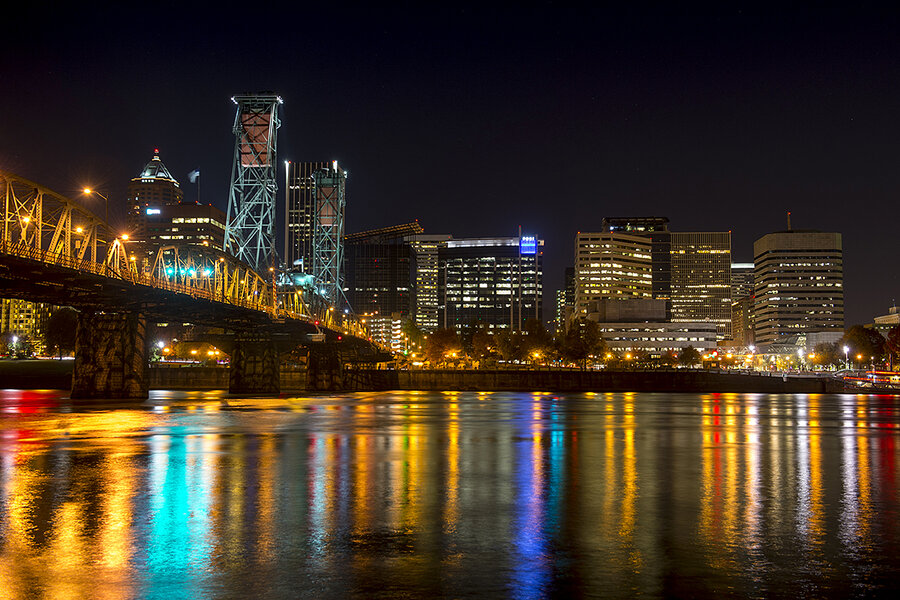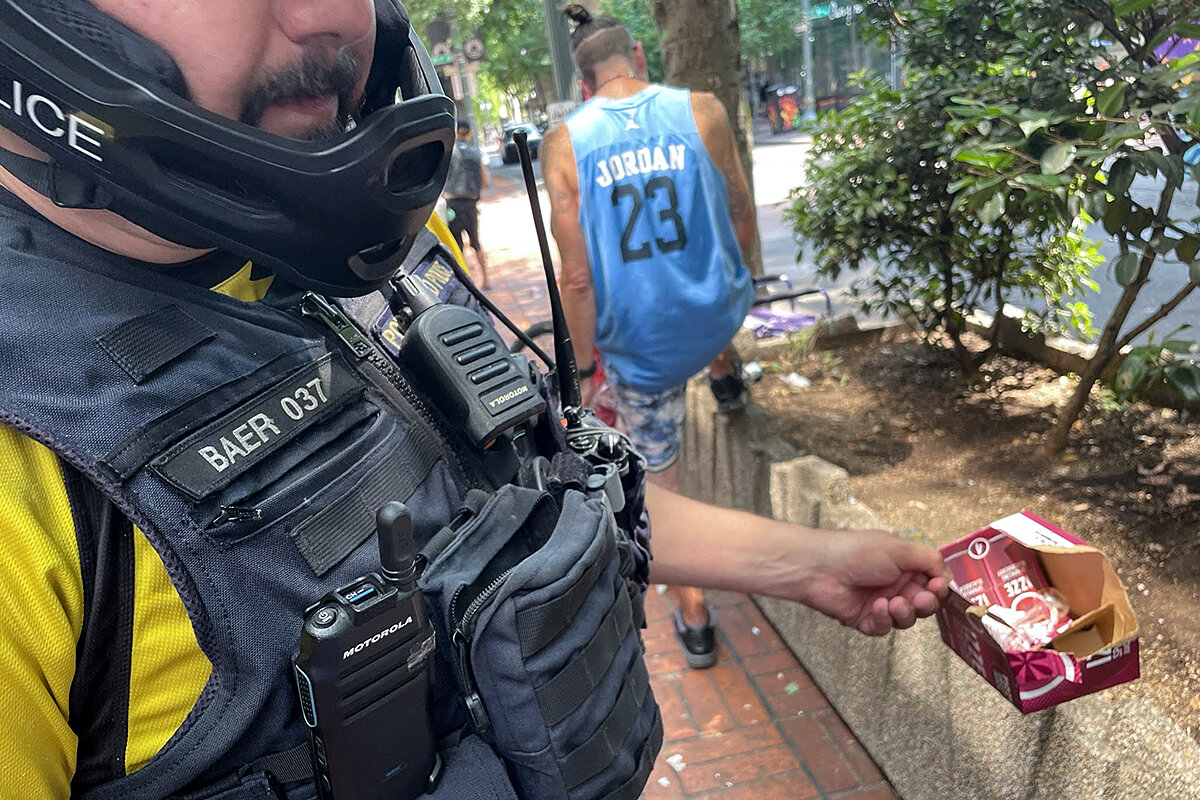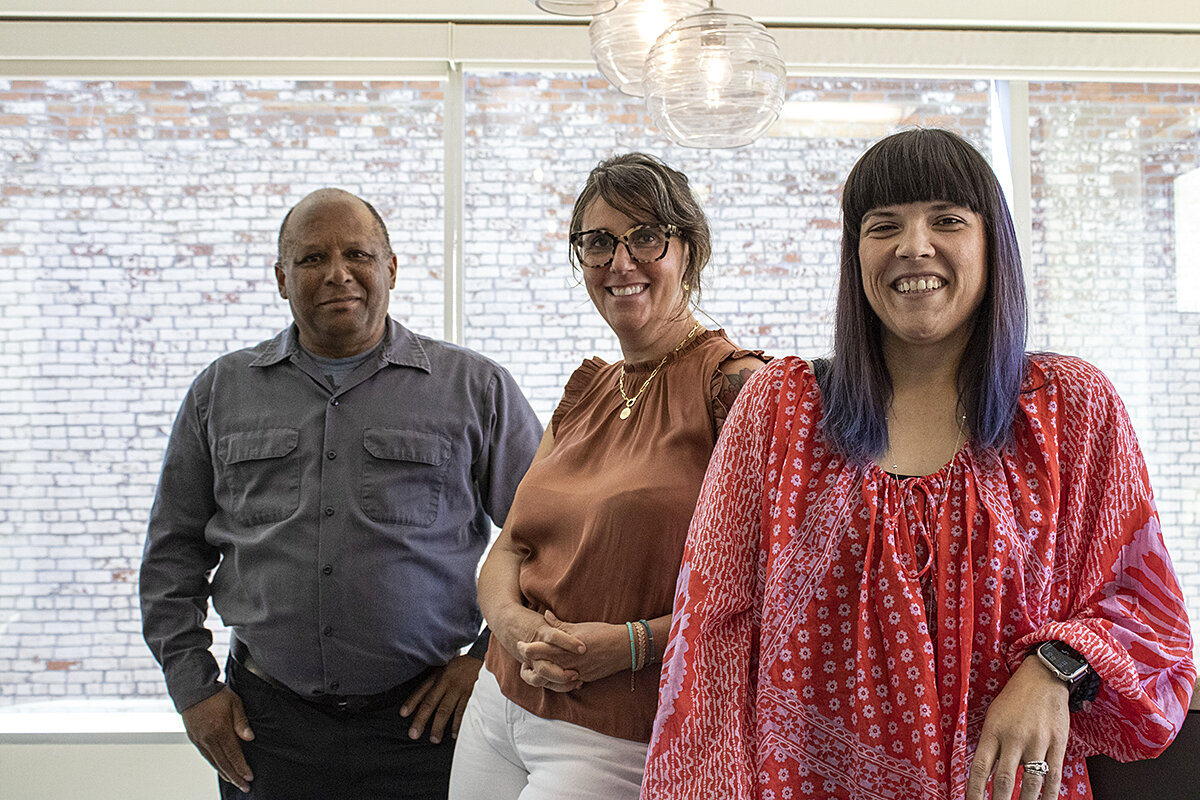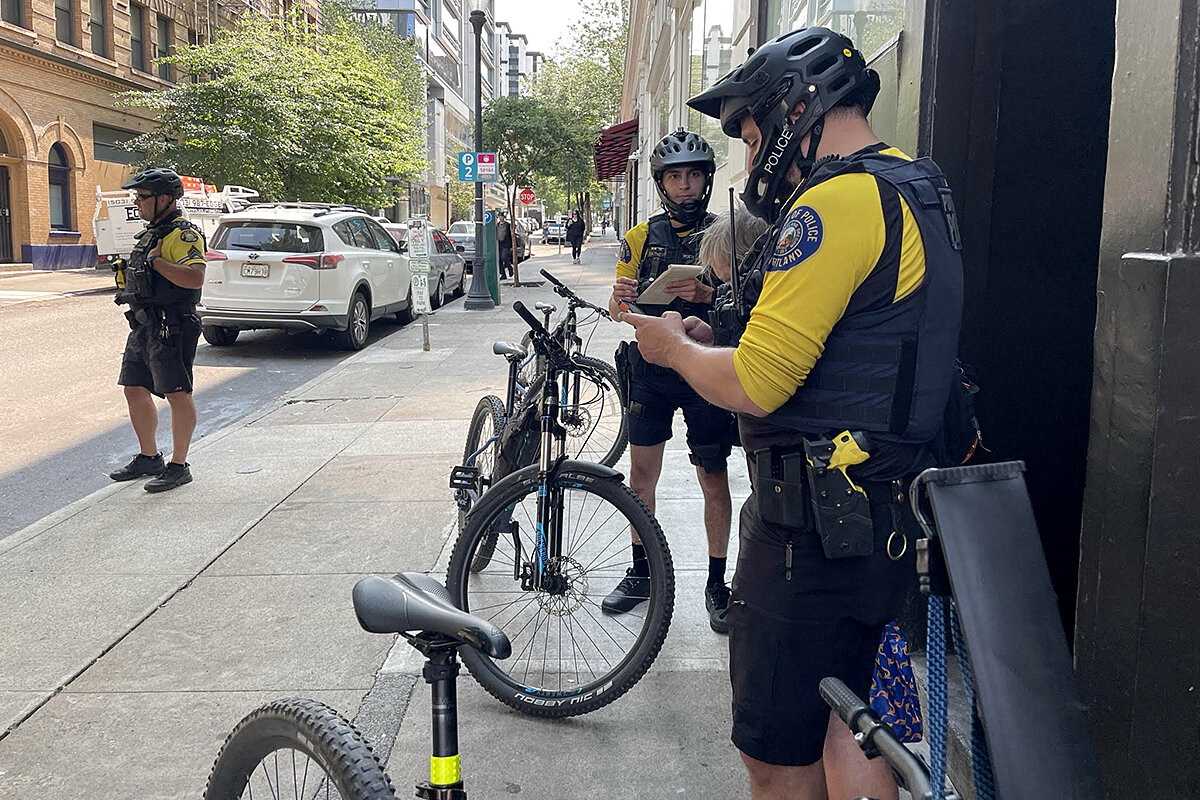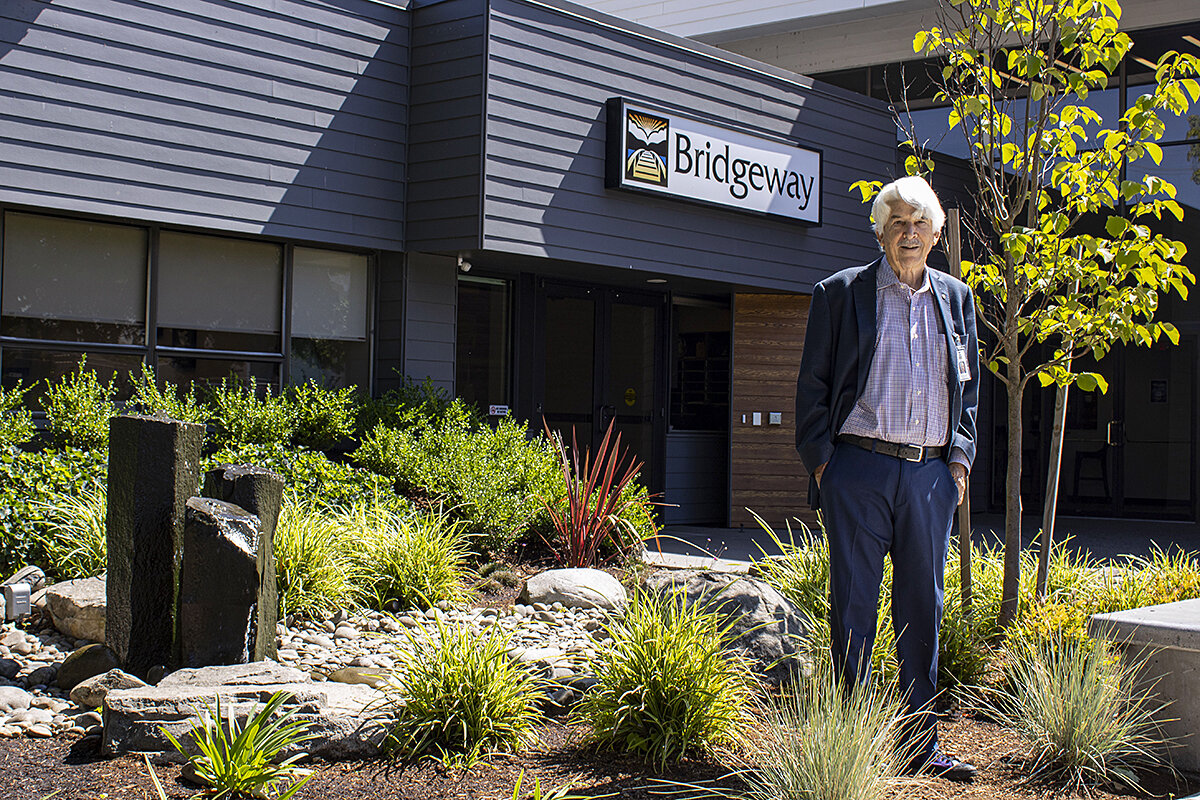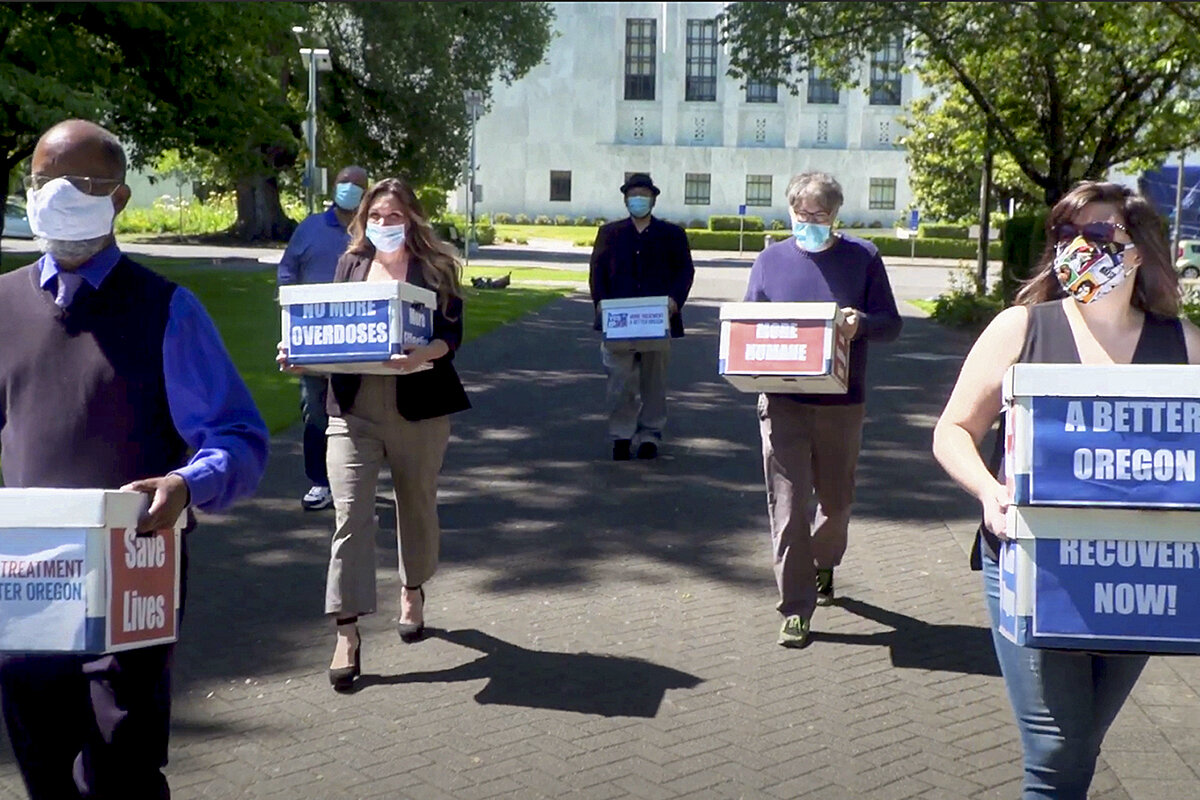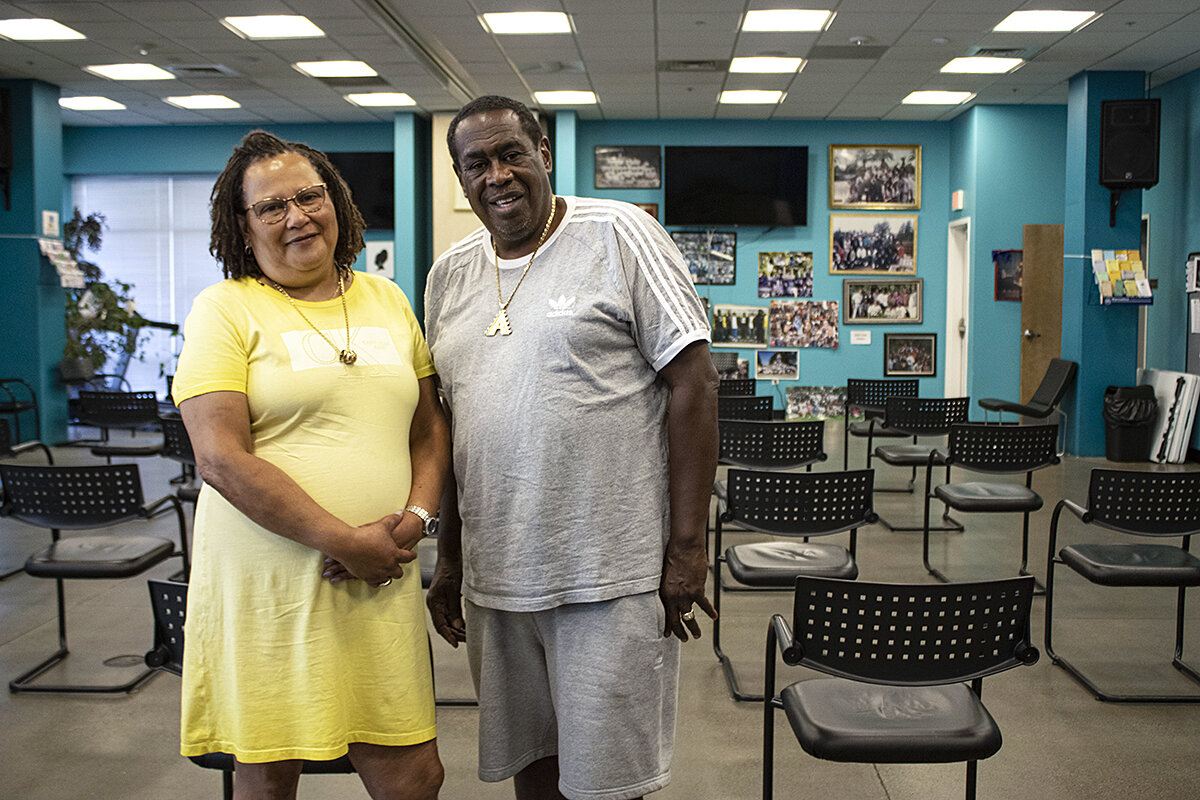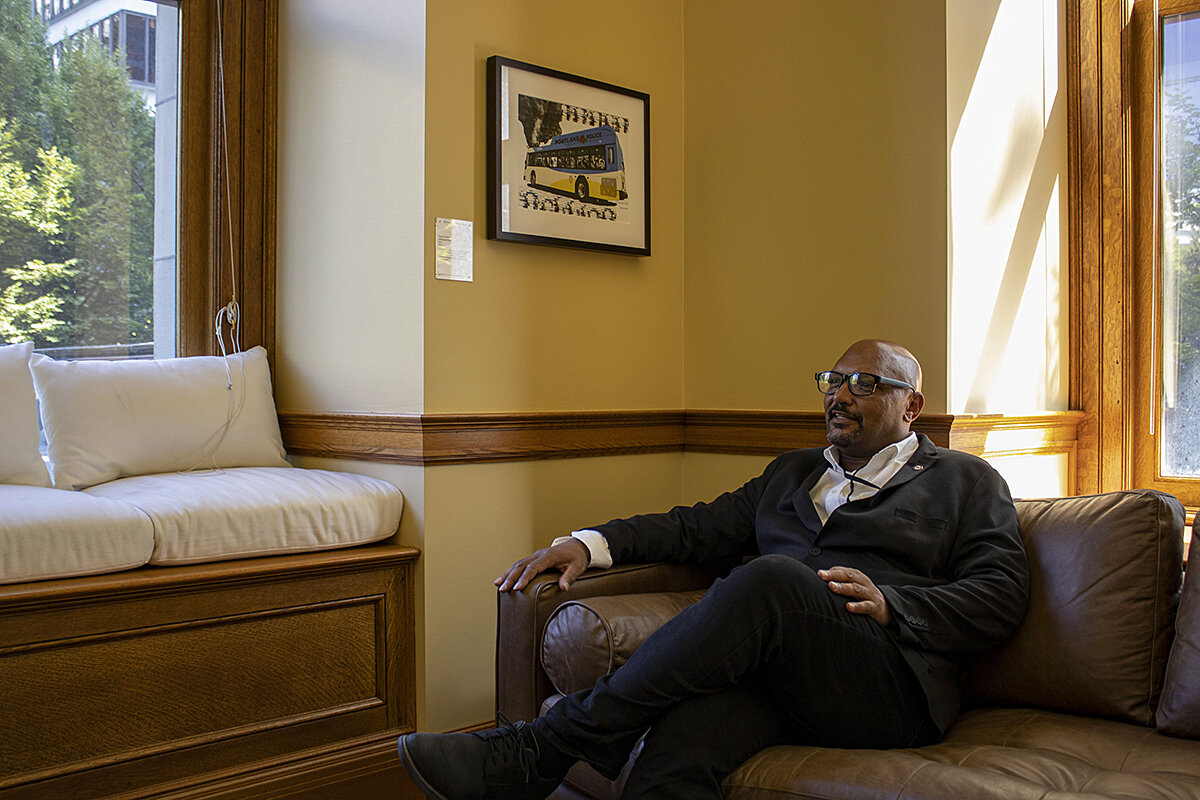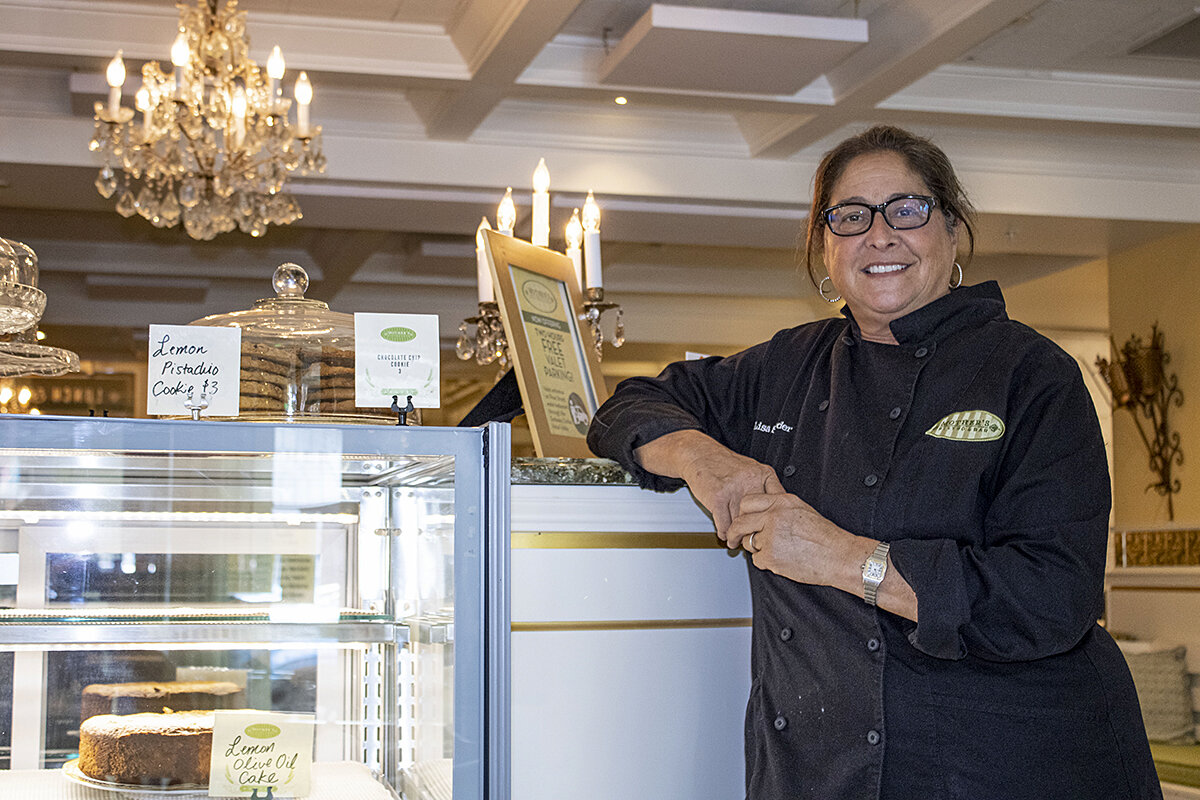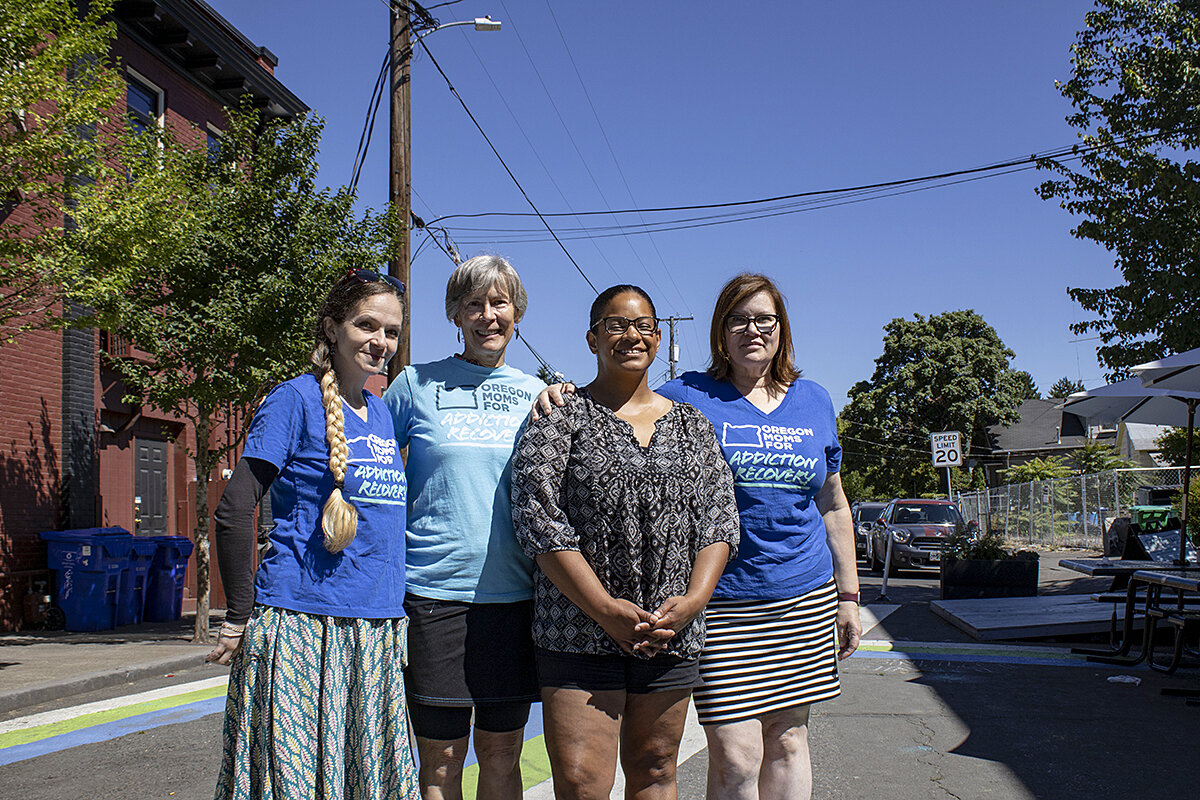Oregon’s bold drug policy isn’t working, yet
Loading...
| PORTLAND, ORe.
Some people smoking fentanyl on the sidewalks in Portland, Oregon, tell the Monitor they’ve always lived here and have used drugs for a while – they’re just less secretive about it now. But just as many say they came to Portland because they heard drugs were easy to get and they wouldn’t get in trouble.
In November 2020, Oregonians overwhelmingly passed referendum Measure 110, the Drug Addiction Treatment and Recovery Act, which decriminalized the possession of small amounts of drugs. Personal possession of controlled substances like fentanyl, heroin, and meth is now a Class E violation subject to a $100 fine – less than for driving without wearing a seat belt. Along with the fine, people receive a hotline number for getting help.
Why We Wrote This
A story focused onWhat’s the most compassionate way to treat those experiencing addiction? Having decriminalized drugs, Oregon is trying to figure that out.
To Measure 110 advocates, the whole point of Oregon’s new program is to give people addicted to drugs the autonomy to abate the problem themselves. But almost three years later, this statewide experiment has not gone according to plan.
People on both sides of the measure have the same goal: reducing drug addiction. The struggle is over how to achieve compassionate care for those experiencing addiction – while preserving a stable sense of community for the city as a whole.
“I don’t think there is one person thinking, ‘I want to eradicate people who use drugs, and I want them to suffer,’” says Tera Hurst, executive director of Health Justice Recovery Alliance, the nonprofit overseeing Measure 110’s rollout. Everyone wants “people living better lives. But it’s ... how you get to that.”
Halfway into asking Portland police officer David Baer what he thinks has happened to his hometown over the past three years – why what used to be one of America’s fastest-growing cities is now rapidly shrinking and has become the right’s favorite laughingstock – I’m cut off.
Mr. Baer had been biking ahead of me, pumping uphill in a downtown that feels eerily quiet for a city of 635,000. He cuts to the left and, in one fell swoop, pulls a spike strip out of its holster and plants it on the street in front of a parked car. Mr. Baer raps on the window, instructing the driver to get out. The man, bent over a straw and piece of foil, protests.
“I saw you smoking fentanyl,” says Officer Baer. The man concedes.
Why We Wrote This
A story focused onWhat’s the most compassionate way to treat those experiencing addiction? Having decriminalized drugs, Oregon is trying to figure that out.
“Just ...” Mr. Baer hesitates before removing the spike strip and re-straddling his bike. “Please don’t do it in public,” he says, and pedals off.
In November 2020, Oregonians overwhelmingly passed referendum Measure 110, the Drug Addiction Treatment and Recovery Act, which decriminalized the possession of small amounts of drugs. Voters in the first (and so far only) state to do so believed they were leading America’s first drug policy overhaul since the war on drugs – an anti-drug campaign initiated in 1971 by President Richard Nixon and expanded in the next decade by President Ronald Reagan.
The war on drugs encouraged criminal punishment for drug-related offenses, including possession, and dramatically increased the incarceration of drug users. For decades, members of racial minority groups have been disproportionately targeted and jailed for drug possession, Measure 110 advocates argued, with nothing to show for these policies but an ongoing national drug epidemic. So Oregon, with its history of pushing bold social policy, decided to try something different.
Under Measure 110, personal possession of controlled substances like fentanyl, heroin, and meth is now a Class E violation subject to a $100 fine – less than for driving without wearing a seat belt.
Almost three years later, this statewide experiment hasn’t gone according to plan.
The number of opioid overdose deaths in Oregon almost doubled between 2020 and 2022. Homelessness has skyrocketed. Homicides in Portland reached record levels in 2021 and 2022. Not all of these problems are traceable to Measure 110, and so far this year, violent crime is down almost 9% in Oregon’s big cities. But a recent local poll found that 63% of Oregonians would support reinstating criminal punishments for drug possession.
“It’s been a lot harder than I think most of us anticipated,” says Tera Hurst, executive director of Health Justice Recovery Alliance, the nonprofit overseeing Measure 110’s rollout. “It was stuff that none of us had ever done. There wasn’t a playbook for it. And the pandemic is the period at the end of that sentence.”
As this groundbreaking approach debuted in 2021, Portland, like the rest of the United States, was in the midst of a global pandemic demanding focus from the state’s leading health officials. Simultaneously, the pandemic fueled a nationwide uptick in drug use and overdoses, as Americans struggled with job losses and rising housing costs. Also simultaneously, the country – and particularly Portland – experienced a reckoning on race and policing, following the May 2020 murder of George Floyd by police in Minneapolis. On top of all this, fentanyl use started rising nationally, especially on the West Coast. Local officials say the drug has transformed opioid addiction because it’s so potent, cheap, and available.
The question now is, can Oregon’s drug decriminalization effort be turned around?
Opponents say Measure 110 was a well-intentioned policy experiment that ran into a buzz saw of outside factors, and by mid-2023 the only option is a massive overhaul or repeal. Supporters say Measure 110 has become a scapegoat. “What’s being sold to the public is ‘Everything is 110’s fault,’” says Ms. Hurst. “People haven’t given it proof of concept yet.”
People on both sides of the measure have the same goal: reducing drug addiction. The struggle is over how to achieve compassionate care for those experiencing addiction – while preserving a stable sense of community for the city as a whole.
“I don’t think there is one person thinking, ‘I want to eradicate people who use drugs, and I want them to suffer,’” says Ms. Hurst. Everyone wants “people living better lives. But it’s how you do that, and how you get to that.”
When we’re a few blocks past the man in the parked car, I ask Mr. Baer what would have happened three years ago if we had come across a man smoking fentanyl in downtown Portland.
“Three years ago,” he says, “this never would have happened.”
In the “before times,” as officers refer to pre-March 2020, working the city’s bike squad was a different job. Their biggest concerns were people drinking beer in public or stealing tip jars off food carts. But that March, the start of the pandemic brought an influx of homeless people camping out downtown, followed by a summer of racial justice protests. Now, it’s citations and drug seizures from dealers all day long.
It’s important to note, however, that the Portland scenes televised over the past few years, with block after block lined with tents, are no longer the reality, now that the city began regulating homeless camping earlier this year. Many neighborhoods surrounding downtown feel idyllic: young families on walks, diners sharing tacos on picnic benches, wildflowers pouring out of gardens attached to colorful bungalows.
Still, the city center is struggling. With hardly any residential properties downtown, the area is void of everyday traffic. In addition, locals say, Portland took COVID-19 precautions seriously and still has a largely remote workforce. A recent study from the University of Toronto found that foot traffic in downtown Portland is 37% of what it was in 2019, before the pandemic.
Businesses have private security guarding their doors, and some blocks have more people smoking fentanyl than not. Passersby periodically approach the bike squad to warn of trouble: a man on the sidewalk who doesn’t appear to be breathing, a naked woman chasing strangers. Some of the people using drugs don’t even know that what they’re doing is illegal. When the police explain that drugs have been “decriminalized,” not “legalized,” people just put away their foil and move down the block, where officers will likely encounter them again.
“You know that game whack-a-mole?” asks Sgt. Jerry Cioeta, an experienced police officer. “That’s what it’s like.”
But before you can really grasp the state of Portland now, say locals, it’s important to understand what it was like before 2020.
Portland’s population surged in the early 1900s as the state’s timber and salmon industries grew. But the Rose City really blossomed as a hub of environmentalism, LGBTQ+ acceptance, and quirkiness over the past two decades. As many young people were priced out of other West Coast cities such as Seattle and San Francisco, they flocked to Portland. A 2012 study by Portland State University found that more young, college-educated people moved to Portland between 2008 and 2010 than to any other metro area except Louisville, Kentucky.
People came here not only for the relative affordability, proximity to both mountains and ocean, and smart urban planning, but also for the city’s unique sense of place. Portland is home to the world’s largest independent bookstore, a Gothic-themed doughnut shop with lines around the block, and the annual World Naked Bike Ride, a protest against dependence on oil. A hit comedy series, “Portlandia,” aired eight seasons in the 2010s with the city’s personality as a key “character” – all the while reinforcing Portland’s view of itself as one of a kind.
But it’s not just Portland. “Oregon has a history of being on the cutting edge of social change,” says Tim Murphy, CEO of Bridgeway Recovery Services in Salem. “That’s why at the top of our Capitol building, there’s a pioneer that’s looking forward.”
In keeping with that cutting-edge identity, Oregon was one of the first states to legalize medical marijuana and later recreational marijuana. In 2020, not only did voters pass Measure 110 by an almost 17-point margin, but also more than 55% passed Measure 109, making Oregon the first state to legalize psychedelic mushrooms.
These types of far-left policies have long made Oregon a target of the right, which uses Portland as an example of what can go wrong with what it calls liberals’ increasingly extreme stances on social issues.
But some Measure 110 opponents see the left using Oregon to its advantage as well – as a pawn in its efforts to end the war on drugs. The New York City-based nonprofit Drug Policy Alliance, “the leading organization in the U.S. working to end the drug war,” its website says, spent millions on the state’s “Vote Yes” campaign. After the measure passed, the executive director of the alliance said she hoped Oregon would start a “domino effect” of decriminalization.
Even before Measure 110, though, Oregon had the second-highest rate of substance use disorder in the country and ranked 50th in access to addiction care. That made it the wrong place to start decriminalization, argue opponents like Mike Marshall, director of Oregon Recovers, a statewide coalition advocating for better recovery services.
“They weren’t here to address Oregon’s addiction problem; they were here to address the war on drugs,” he says. “Politically, they needed a state where they could win decriminalization at the ballot box.”
This law “would never have passed” the legislature, even in Oregon’s Democratic majority, says state Rep. Rob Nosse, who “absolutely” voted for Measure 110.
“Legislatures, by their nature, are incremental bodies,” says Mr. Nosse at a picnic table outside Dot’s Cafe, a local bar in his Northeast Portland neighborhood. “To decriminalize all of this? That’s a big swing. Plenty of my progressive Democrat colleagues, I’m sure, were quietly ‘no’ votes.”
The fact that voters passed the mandate, and so handily, means it should be taken “most seriously,” says Ms. Hurst. But that also makes it difficult to implement.
“No lawmaker is owning it and saying, ‘I care; I want to make sure this thing happens,’” she adds.
Under Measure 110, the process is supposed to look something like this: Police officers encounter someone using drugs (dealing is taken more seriously). Instead of arresting the person, the officer hands out a citation with a $100 fine along with a hotline number to call for a social services screening. During the call, the operator can make a referral to a nonprofit offering peer support or housing. (These service providers across the state can now apply for grants from cannabis tax revenue to boost their offerings.) If the person using drugs calls the hotline and participates in the health screening, the $100 fine will be waived. (If someone neither pays the $100 nor does the health screening, the citation remains on his or her record as an unpaid fine.)
When Julia Mines first heard about this new system, she found it laughable. After all, it took Ms. Mines serving time in prison for drug possession for her to finally get sober and find support groups at The Miracles Club, a recovery center for Black Portlanders where she now serves as executive director. But the more she thought about how the war on drugs has harmed generations of Black Americans, she realized Measure 110 was something she could “get behind.”
Supporters like Ms. Mines are asking for more time due to the troubled rollout. After its win in November 2020, Measure 110 took effect in February 2021. But not until July 2022 – a year and a half later – did cannabis tax funds start reaching nonprofits.
During this time, the Recovery Center Hotline received 119 calls, an Oregon secretary of state audit found, costing over $7,000 per call because of the expense of keeping the line open 24/7. Of those 119 callers, fewer than 30 expressed interest in treatment resources, according to the audit.
“It’s been a disaster,” says Democratic City Council Commissioner Mingus Mapps, who voted for Measure 110 and is running for Portland mayor in 2024. “It’s mortifying” that the number of people who have called the hotline could probably fit in here, he adds, motioning around his corner office in Portland’s City Hall. “It’s clear that the assumptions behind Measure 110 were fundamentally flawed. We assumed that people who are addicted to fentanyl, when presented with a ticket, are going to call a phone number and seek help.”
To Measure 110 advocates, the whole point of Oregon’s new program is to give people addicted to drugs the autonomy to abate the problem themselves. But almost all of those advocates, with the exception of Health Justice Recovery Alliance employees like Ms. Hurst, say they would support adding some consequences if people don’t follow through on recovery services. A healthy balance, they say, of carrots and sticks.
“Most people come into treatment because of some kind of pressure: pressure from their family, friends, a boss, police, a judge,” says Keith Humphreys, a psychiatry professor at Stanford University who has cautioned the state Senate about Measure 110. Even Portugal, he adds, which decriminalized personal possession of drugs in 2001 and is seen as a model for Portland, places social and legal pressure on people to seek treatment. “It doesn’t mean throwing people in jail, but there has to be some kind of consequence,” Dr. Humphreys says.
More than two decades into decriminalization, however, Portugal is having second thoughts. Earlier this summer it was reported that, after a spike in drug use and crime, the country is rethinking its policy.
Some people smoking fentanyl on Portland’s sidewalks tell the Monitor they’ve always lived here and have been using drugs for a while – they just used to be more secretive about it. But just as many say they came to Portland because they heard drugs were easy to get and they wouldn’t get in trouble.
Portland Police Association President Aaron Schmautz knows the city is attracting drug users. “Any argument against that, to me, is just silly,” he says. Now that the city is in this situation, he adds, it has to ask, what is the compassionate solution?
“Is it benevolent to hold people accountable and do something with them?” he asks. “Or is it OK to let them – I mean, I walked by five different people smoking fentanyl in the two blocks from my car to here, and most of them are in an alcove with cardboard covering them. One guy is just laying there. ... When society says, ‘I’m not going to say something because that person has a right to lay on that sidewalk dying,’ that to me is a cultural departure from what we have historically done.”
Within a national conversation about how to involve police in issues like drug addiction, arguably no city is having a harder time than Portland. For more than 100 consecutive nights following the murder of Mr. Floyd, protests – which often turned violent – flooded Portland’s downtown. Then-President Donald Trump sent in federal forces, which further fueled the opposition. Officer Cioeta describes it as something that “no other police department in the history of the United States has ever gone through.” In the aftermath of that, along with subsequent funding cuts and high attrition, the force feels “demoralized,” he adds.
Many also feel excluded. Portland police officers say they’ve never been included in conversations about implementing Measure 110. When asked about that, Ebony Clarke, the Oregon Health Authority’s behavioral health director, tells the Monitor that one of her “key goals” going forward is to have quarterly convenings that bring everyone to the table. Mr. Schmautz, the Portland Police Association president, says he hasn’t heard anything about this.
“Both sides of the conversation agree that people need help,” says Mr. Schmautz. “But ... there are people in this conversation who feel like police are a part of the problem, and I don’t agree with that.”
From this comes a vicious feedback loop of resentment that has hardened between police and some locals.
“The police got passive-aggressive” after the 2020 riots, says Lisa Schroeder, owner of Mother’s Bistro, whose revenue is one-third of what it was in 2019. She adds that once she called the police to help with a customer’s broken car window, and they told her there was nothing they could do.
“We are so far gone,” says Ms. Schroeder, her head in her hands. “I’m starting to get scared that we can’t come back.”
She voted for Measure 110 but says if she had it to do again, she would vote against it.
And she might get the chance. Several sources tell the Monitor that anti-Measure 110 activists will soon start collecting signatures for their own ballot initiative ahead of the 2024 election, although nothing has been officially launched.
But there are signs of progress. In July the governor signed a bipartisan bill, led by state Representative Nosse, to increase the Oregon Health Authority’s oversight and ease the flow of funding. After the 17-month delay, the cannabis-funded grants are out the door, and new programs are beginning to come online. Almost $265 million had been allocated by September 2022 to 160 partners across the state.
The Oregon Health Authority’s report for the final quarter of 2022 shows an increase in the number of people engaging with substance use disorder treatment, housing assistance, and peer support services.
With the $3.2 million granted to The Miracles Club, it has added more mentoring programs and opened a nine-bed transitional home for Black women new to their sobriety.
O’Nesha Cochran, community liaison for The Miracles Club and a member of the Oregon Health Authority’s Oversight and Accountability Council, knows firsthand the value of those programs. After 15 years in and out of prison, she got clean at The Miracles Club in 2011. But if it had had the funding then that it has now to do harm reduction services in the community – handing out socks, needles, and Narcan – maybe, Ms. Cochran says through tears, she would have found this place sooner. Gotten clean sooner. And found this better life sooner.
With the $11 million awarded to Mr. Murphy’s Bridgeway, they were able to start a program to help the significant others of those experiencing addiction as well as build up a system that connects Bridgeway patients with other community services. And most notably, more than half of Bridgeway’s grant is going toward the construction of a 20,000-square-foot detox clinic that will be built in the parking lot behind its building – adding 36 beds to its current 20. Bridgeway is the only detox facility in a four-county radius, but beyond Mr. Murphy’s grant, Measure 110 does little to increase residential treatment statewide. A spokesperson for the Oregon Health Authority tells the Monitor there are “no exact numbers” for how many new treatment beds will come online with Measure 110 funding.
Parents whose children are using drugs know all about the state’s “lack of beds,” as Oregon Moms for Addiction Recovery board chair Mary Beth Henry puts it. She says her son had to go to Washington to get help in 2021 when they couldn’t find an open bed in Oregon. Kelly Hernandez went through a similar situation with her son.
Four mothers, all members of the Oregon Moms group, sit around a picnic table in front of Bipartisan Cafe in Northeast Portland, sharing pastries and their stories. They wear glasses and sensible shoes. Ms. Henry biked to coffee in a skort. At first glance these women don’t seem like the faces of Oregon’s addiction crisis. They say that’s an important point.
“People love to say, ‘Oh, Portland is so gross.’ It’s easy to say things from afar, but we’re real people,” says Ms. Hernandez. “We had our kids, and we raised them with intent. We planned birthday parties, and we took them to school. ... We did everything you’re supposed to do, and then it just kind of fell apart.”




